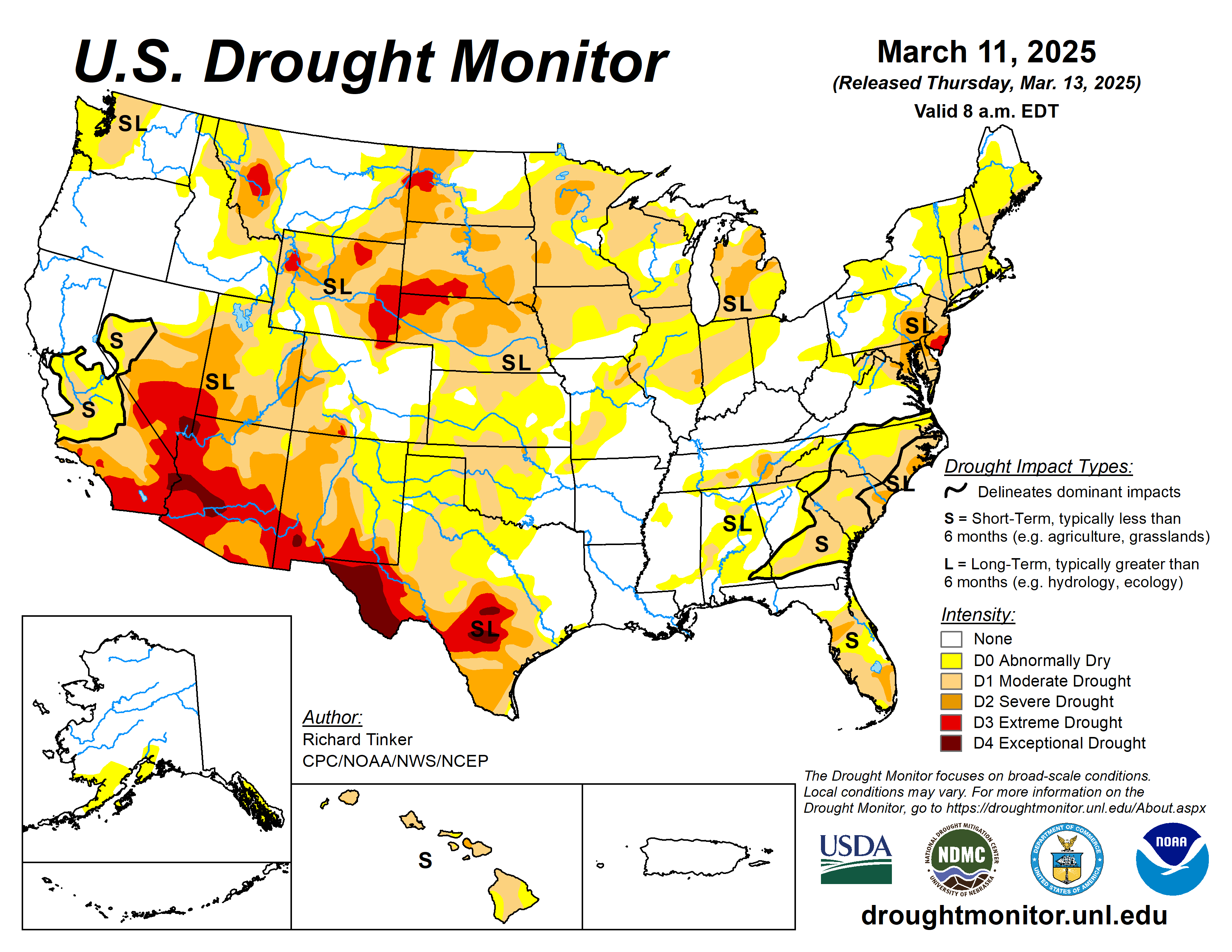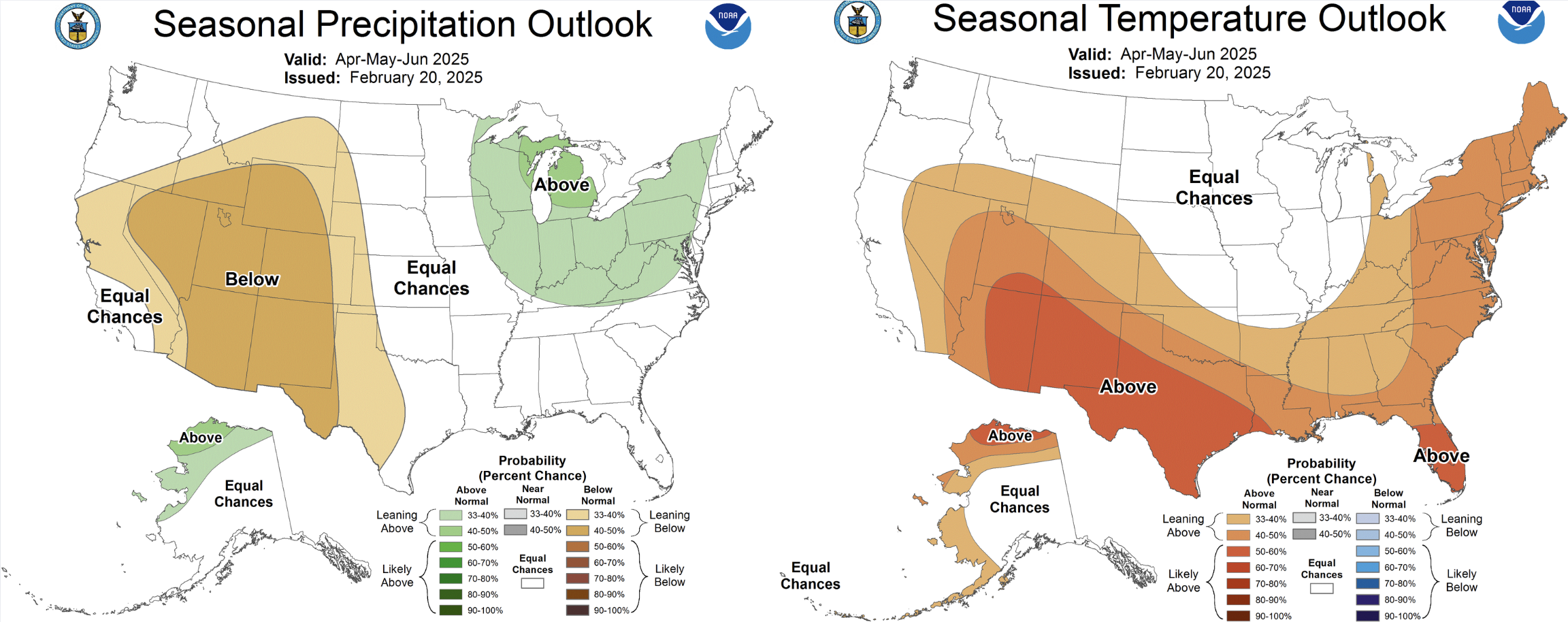AGRONOMICSUPPORT
YOU CAN TAKETO THE FIELD
Drought, Delays and Weeds — Is Your 2025 Planting Plan Ready?
Planting season always brings its share of hurdles. But 2025 is shaping up to be especially challenging. Between securing financing, preparing for drought conditions, managing a delayed start and staying ahead of weed and pest pressure, farmers have a lot to consider before heading to the field.
The key to success? Planning ahead and making strategic decisions.
Key Takeaways:
- With financing concerns, drought risks, delayed planting and weed pressure all in play for 2025, farmers must make proactive decisions now to stay ahead.
- With many regions already facing below-average soil moisture, adjusting planting strategies based on real-time weather data will be critical to maintain yield potential.
- A cold, wet spring may push planting behind schedule; farmers will need to be flexible with product selection and field timing.
Here's what you need to know to set yourself up for a strong start this season:
Secure Your Financing Early
Before the first seed goes in the ground, lock in a credit line. Operating costs aren't getting any cheaper, and with tight margins, a strong financial plan helps farmers make timely input decisions without added stress.
Waiting too long can mean higher interest rates, fewer options and delayed access to inputs. Farmers who secure financing early will have more flexibility with seed, fertilizer and other input purchases.
Multiple financing options are available to support your operation, including 0% financing programs through LG Seeds’ partnerships with Rabo AgriFinance® and John Deere® Financial. Designed specifically for row crop operations, these programs are subject to specific terms and conditions. Contact your LG Seeds representative to learn more about the latest financing opportunities.
Prepare for Drought Conditions
According to the U.S. Drought Monitor, many parts of the country are already experiencing below-average soil moisture. Western regions face higher drought risks heading into the 2025 planting season.

Sourced from: https://droughtmonitor.unl.edu/
A dry fall and winter have left many areas low on soil moisture. Spring predictions suggest some regions could face microdrought conditions early in the season. Without sufficient moisture at planting, emergence and early root development could be at risk — which could lead to uneven stands and long-term stress.
To mitigate drought impact and protect yield potential, focus on three key areas:
1. Product selection: Choosing drought-tolerant products is one of the most reliable ways to prepare for dry conditions. Growers should:
- Select products with strong drought tolerance ratings — LG Seeds offers options specifically bred to maintain yield potential even during periods of low rainfall. LG63C82, the 2024 DroughtGuard® champion, has demonstrated outstanding performance in back-to-back seasons across farming practices and weather conditions.
- Consider early vigor and rooting characteristics — Deeper root systems help plants access moisture deeper in the soil profile. Choices like LG52C90 combine strong roots and robust early-season vigor.
- Balance maturity selections — In drought-prone areas, a mix of early and mid-maturity products can help spread risk and improve harvest flexibility.
2. Soil moisture conservation: During a dry start, it’s critical to preserve available moisture. Consider these practices:
- Reduced tillage or no-till systems — Minimizing soil disturbance helps retain moisture and improves soil structure. This makes it easier for roots to access water.
- Cover crops — When properly managed, cover crops can reduce evaporation, improve water infiltration and enhance soil organic matter. These crops can help fields more effectively hold onto limited rainfall.
- Moisture-sealing techniques — Residue management and strip-tilling can help conserve surface moisture ahead of planting.
3. Spring moisture predictions and adjustments: Drought conditions demand flexibility in planting decisions. Growers should:
- Monitor real-time weather forecasts — Short and long-term predictions can help inform seedbed preparation, planting timing and input management.
- Adjust planting depth based on moisture availability — In dry soils, deeper planting (within product guidelines) can help ensure access to moisture for germination.
- Modify seeding rates strategically — Lower populations can reduce plant competition for water, while higher populations may still work if subsoil moisture is available.
With early-season dryness in play, it's essential to have a moisture management strategy before planting begins. Farmers who take a proactive approach — from product selection to soil conservation — will be better positioned to handle drought stress and maximize yield potential.
Adjust Your Plan for Delayed Planting
While some regions are facing drought, others are experiencing the opposite challenge. A cold, wet spring with limited snowfall has already pushed fieldwork several weeks behind schedule in parts of the Midwest and Eastern regions. Many fields are still holding excess moisture, and the risk of late-season cold snaps could delay planting even further. These regional variations reflect what we saw in 2024, where excessive early-season moisture in the Corn Belt caused challenges for many growers.
Growers facing tight planting windows need to make strategic adjustments to keep yield potential intact. Here are three techniques to keep in mind:
1. Stay flexible with planting windows: The urge to get seed in the ground quickly is strong. But planting into wet or compacted soils can cause more harm than waiting for better conditions. Poor conditions can lead to:
- Compaction issues that restrict root development
- Uneven emergence and poor stand establishment
- Increased risk of replanting, which will cost more time and money
Instead, growers should:
- Monitor soil temperatures closely — Corn typically requires 50°F+ for good germination, and soybeans need closer to 55°F+.
- Wait for the right soil moisture conditions — Fields should be firm but not sticky to prevent sidewall compaction.
- Prioritize well-drained fields first — Low-lying or poorly drained areas may need extra time to dry.
Current temperature and precipitation trends across the U.S. highlight the variability growers will face this spring. While some regions are warming up quickly, others remain below average, delaying soil warm-up. Similarly, uneven rainfall patterns mean some fields are drying out fast, while others stay saturated.
Keeping a close eye on these conditions will help growers make more informed decisions and take advantage of the best available planting windows.

Sourced From: https://www.cpc.ncep.noaa.gov/products/predictions/long_range/seasonal.php?lead=2
2. Reevaluate product maturity choices: Delayed planting means less time for crops to reach full maturity before the first fall frost. Growers should:
- Consider switching to earlier — maturing products to compensate for lost growing degree days (GDDs). Some products can handle late planting better than others without sacrificing too much yield potential.
- Factor in drying costs — Full-season products planted late may not fully mature before harvest, leading to higher moisture content and drying expenses.
3. Monitor soil conditions with sensors and probes: Spring weather is unpredictable, and soil conditions can vary drastically across a field. Using in-field soil temperature and moisture sensors can help pinpoint optimal planting times and prevent costly planting errors. Avoid relying solely on air temperatures. Soil warms at a slower rate, so ground conditions can lag behind air temperature shifts.
Patience pays off. Jumping the gun in wet or cold conditions often causes more damage than waiting a few extra days for fields to dry. While delayed planting adds pressure, making strategic decisions — like adjusting product selection, monitoring soil conditions and avoiding compaction — can help protect yield potential in a shorter growing season.
Stay Ahead of Weed and Pest Pressure
A cold, wet spring creates significant challenges for weed control. Saturated soils delay herbicide activation, giving weeds a head start. Meanwhile, insect hatches are pushed back, stacking up pest pressure later in the season.
These challenges were evident in 2024, when excessive early-season moisture in many regions created ideal conditions for aggressive weed growth and insect pressure.
- Use layered residuals — A strong pre-emergent herbicide with overlapping residuals can help control early-season weeds, even in tough conditions.
- Scout fields regularly — Delayed planting means delayed pest pressure, so it's critical to monitor emerging crops for signs of weed and insect competition.
- Consider robust seed traits — Advanced technology like SmartStax® PRO provides powerful protection against corn rootworm and other key pests. Choices like LG63C32 SmartStax PRO have demonstrated exceptional performance under various conditions.
- Avoid waiting too long on post-emergence applications — Weeds will be aggressive this season, and timely post-emergence applications will be key to keeping fields clean.
Growers who fall behind on weed and pest control could spend the rest of the season playing catch-up. Starting clean and staying clean will help maximize yield potential.
The Bottom Line
With financing concerns, drought risks, delayed planting and weed challenges all playing a role, 2025 is shaping up to be a complex planting season. But growers who plan ahead and make intentional decisions now will be in the best position to succeed.
For product recommendations, agronomic support and financial options that fit your farm's needs, reach out to your LG Seeds representative today.






Agronomy Team